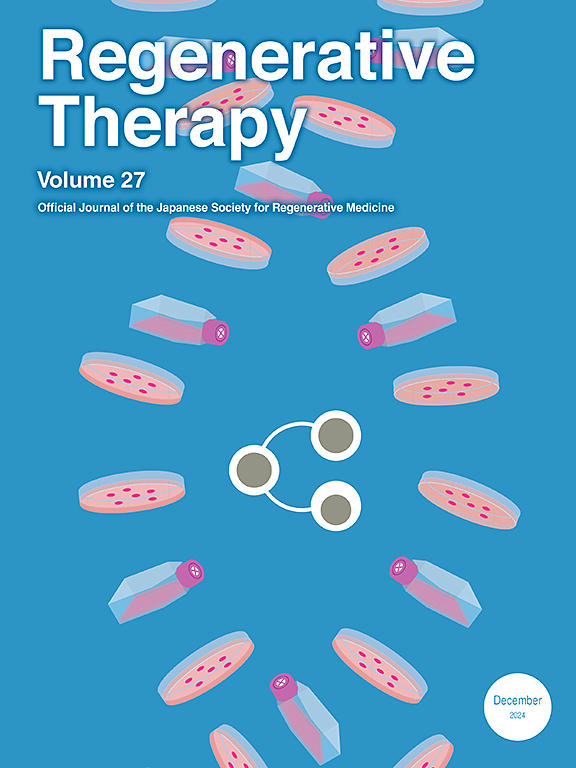Therapeutic effects of mesenchymal stem cell conditioned media on streptozotocin-induced diabetes in Wistar rats
IF 3.4
3区 环境科学与生态学
Q3 CELL & TISSUE ENGINEERING
引用次数: 0
Abstract
Cell-based therapy is a new direction of treatment of diseases such as type 1 diabetes mellitus (T1DM); but unfortunately, its severe side effects include immunogenicity and tumor development. Using Mesenchymal stem cells conditioned medium (MSCs-CM) may be an alternative therapy to avoid stem cell risks, preserving effectiveness and demonstrating noticeably increased levels of cytokines, angiogenic factors, and growth factors that encourage and support regenerative processes. In the current work, we examined the effects of MSCs-CM injected in tail vein and pancreas directly compared with the standard antidiabetic drug, glimepiride in streptozotocin-induced type 1 diabetic rats. Fifty adults Male Wistar rats were allocated equally into five groups: normal, diabetic control and three diabetic groups treated respectively with glimepiride, MSCs-CM injected daily into tail vein (MSCs-CMT) and MSCs-CM injected directly in pancreas (MSCs-CMP); all treatments continued for 28 days. The treatments produced a significant improvement in blood glucose level and glycosylated hemoglobin A1c (HbA1c), serum insulin level and lipid panel, and pancreas apoptosis-related markers including B cell lymphoma-2 (Bcl-2) and vimentin. In addition, the treatments resulted in suppression in the oxidation stress and enhancement in the antioxidant, which were manifested by the suppressed lipid peroxidation and the increased antioxidant markers (glutathione, catalase and superoxide dismutase) in the pancreas. In association with the significant decrease in tumour necrosis factor-alpha (TNF-α) and interleukin-1beta (IL-1β) and a significant increase in interleukin-10 (IL-10) levels, the inflammatory mediator nuclear factor-kappa B (NF-κB) expression was significantly decreased by MSCs-CMT and MSCs-CMP. The histological amelioration of the pancreatic islet cells assured our study especially in MSCs-CMP group than MSCs-CMT which supports islet regeneration and elevated circulating insulin. These results imply that MSCs-CM infusion has therapeutic benefits in T1DM rats and may be a viable novel therapeutic approach; MSCs-CMP was shown to be more effective than glimepiride and MSCs-CMT. The mechanisms of antidiabtic actions may be mediated via the antioxidant, anti-apoptotic and anti-inflammatory effects.
间充质干细胞条件培养基对链脲佐菌素诱导的 Wistar 大鼠糖尿病的治疗效果
细胞疗法是治疗1型糖尿病(T1DM)等疾病的新方向;但不幸的是,其严重的副作用包括免疫原性和肿瘤发生。使用间充质干细胞条件培养基(MSCs-CM)可能是一种替代疗法,既能避免干细胞风险,又能保持疗效,还能明显提高细胞因子、血管生成因子和生长因子的水平,促进和支持再生过程。在当前工作中,我们研究了在链脲佐菌素诱导的1型糖尿病大鼠中,将间叶干细胞-CM直接注射到尾静脉和胰腺,与标准抗糖尿病药物格列美脲进行比较的效果。将 50 只成年雄性 Wistar 大鼠平均分为 5 组:正常组、糖尿病对照组和 3 个糖尿病组,分别使用格列美脲、每日尾静脉注射间充质干细胞(间充质干细胞-CMT)和直接在胰腺中注射间充质干细胞(间充质干细胞-CMP)进行治疗;所有治疗均持续 28 天。这些疗法显著改善了血糖水平和糖化血红蛋白 A1c(HbA1c)、血清胰岛素水平和血脂组合,以及胰腺凋亡相关标记物(包括 B 细胞淋巴瘤-2(Bcl-2)和波形蛋白)。此外,治疗还能抑制氧化应激,增强抗氧化能力,具体表现为抑制了胰腺的脂质过氧化反应,增加了抗氧化标志物(谷胱甘肽、过氧化氢酶和超氧化物歧化酶)。在肿瘤坏死因子-α(TNF-α)和白细胞介素-1β(IL-1β)水平显著下降、白细胞介素-10(IL-10)水平显著上升的同时,间充质干细胞-CMT和间充质干细胞-CMP还显著降低了炎症介质核因子-卡巴B(NF-κB)的表达。与间充质干细胞-间充质干细胞治疗组相比,间充质干细胞-间充质干细胞治疗组的胰岛细胞组织学特征明显改善,这支持了胰岛的再生和循环胰岛素的升高。这些结果表明,间充质干细胞-间充质干细胞输注对 T1DM 大鼠有治疗作用,可能是一种可行的新型治疗方法;间充质干细胞-间充质干细胞输注比格列美脲和间充质干细胞-间充质干细胞输注更有效。抗糖尿病作用的机制可能是通过抗氧化、抗凋亡和抗炎作用介导的。
本文章由计算机程序翻译,如有差异,请以英文原文为准。
求助全文
约1分钟内获得全文
求助全文
来源期刊

Regenerative Therapy
Engineering-Biomedical Engineering
CiteScore
6.00
自引率
2.30%
发文量
106
审稿时长
49 days
期刊介绍:
Regenerative Therapy is the official peer-reviewed online journal of the Japanese Society for Regenerative Medicine.
Regenerative Therapy is a multidisciplinary journal that publishes original articles and reviews of basic research, clinical translation, industrial development, and regulatory issues focusing on stem cell biology, tissue engineering, and regenerative medicine.
 求助内容:
求助内容: 应助结果提醒方式:
应助结果提醒方式:


